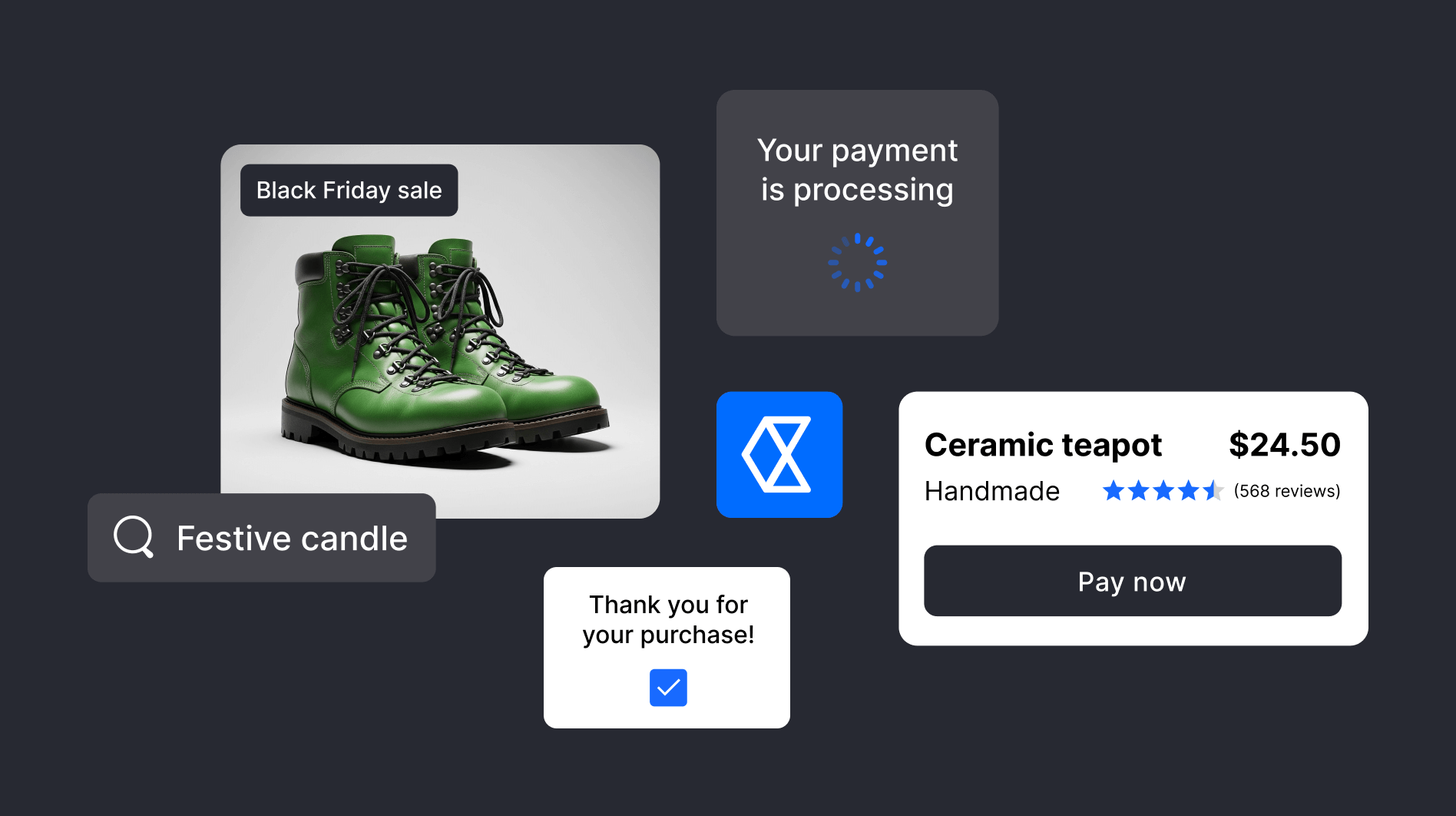As more commerce shifts online, consumers are experimenting with new payment methods at a rate never seen before; and according to our research, 30% of consumers in Europe want to try new payment methods based on their experiences in 2020.
Why does understanding the changing trends in consumer behavior matter?
Well, because 60% of online consumers will abandon their cart if they’re unable to pay with their preferred payment method, or if they have a bad checkout experience. This can have a big impact not only on your relationships with your existing customers, but on your ability to reach new customers – and access all the brand- and revenue-boosting benefits they bring.
But that's not all. Using the right payment method can lower the cost of transactions, improve acceptance rates, and strengthen security. So how exactly can businesses use alternative payment methods (APMs) – plus a range of other strategies, such as localization, checkout optimization, and PCI compliance – to reach new customers and supercharge growth?
Read on – we’re looking at five ways you can improve your payment method strategy to reach new customers in 2024.
1. Offer alternative payment methods
Ecommerce shoppers want a seamless checkout experience. That, of course, means no fuss or friction – such as too many form fields, too many steps in the payment flow, or the obligation to login to make a purchase – when they come to check out.
But it also means offering them the ability to complete their purchase in the payment method they choose. And, despite the fact that debit and credit cards – in the US, at least – are still the most popular way to pay, a variety of alternative payment methods are rising to challenge their dominance. These include:
- Prepaid cards
- Cash-based payments (electronic cash or e-cash, such as Oxxo or Boleto)
- Real-time bank transfers (such as FedNow, iDEAL, or Sofort)
- Direct debit (such as ACH or BACS)
- Electronic wallets or e-wallets (such as Alipay or PayPal)
- Mobile wallets or pass-through digital wallets, such as Apple Pay or Google Pay
- Buy now, pay later (BNPL) providers, such as Klarna
Enabling your customers to pay their way – from wherever they are in the world – will decrease cart abandonment, boost customer loyalty, and offer a better payment experience.
Crucially, more payment methods will also expand your business’s horizons to new markets. And if you’re working with the right payment processor, such as Checkout.com, you’ll be able to switch on local acceptance methods to ensure high issuer approval rates in those countries – allowing you to internationalize your strategy, while optimizing your revenue.
What’s more, you’ll be able to reach new customers on a domestic level, too. By increasing the amount of payment methods you offer at your ecommerce store’s checkout, you’ll be able to re-engage customers that may have limited access to mainstream ways to pay. Through this lens, increasing the breadth of the payment methods you offer isn’t just a balm for your sales and revenue – but an important aspect of financial inclusivity, too.
That said, it’s important to know how many payment methods is too many – a question our in-depth guide can help your business answer.
Alternatively, download our guide to switching on the right payment methods to tailor your strategy to the unique needs of your business and customer base.
2. Localize your strategy
Accepting alternative payments powers global growth, yet assuming that what works in one country or region will work everywhere else is a mistake.
Payment preferences differ between countries and regions as much as within them. Kakao Pay, for instance, is Korea’s most popular way to pay, while Bancontact is Belgium’s payment method of choice. French card scheme Cartes Bancaires has over 71 million cards in France – so, vital if you plan to expand there – while in the Netherlands, 70% of customers use iDEAL when paying for goods and services.
Local payment methods, however, are just one aspect of localizing your strategy to reach new customers. You’ll also need to think about ecommerce localization: the process of tailoring your online store’s customer experience to different geographic audiences.
This includes making changes to your website (such as your homepage, your checkout page, and your blog) as well as your product names and descriptions. You’ll need to translate your site, too, so users don’t have to rely on search engines’ translation features to understand them.
Localizing your store’s visuals is a good idea, too. You’ll want to ensure the people reflected in your website’s images – especially if they’re from stock – are an accurate representation of the main demographics and aesthetics of the region you’re targeting. (Images set against backdrops of dense rainforest, for example, won’t resonate in places like the Middle East, where skyscrapers and desert hog the landscape.)
Plus, by localizing your ecommerce store’s prices, shipping rates, and delivery times, customers will be left with no indecision as to how much your products will be costing them after currency conversion is taken into account. This clarity helps drive down abandoned carts, and built trust – while boosting consumer loyalty and perceptions around your brand.
3. Consider the data
In optimizing your payments strategy to reach new customers, you first need to understanding what is – and what isn’t – working for your business’s existing ones.
For this, access to data is key.
Your transaction data, for instance, provides insights into which payment methods deliver the best checkout conversion and cost the least to accept. You’ll also be able to get to grips with which payments have the best acceptance rates, and which ones can best mitigate chargebacks – and their damaging impact on your business’s revenue and reputation.
You can also lean on wider market data to glean clues as to payment preferences, sector benchmarks, and comparative payment method costs throughout different regions.
So, sure – when it comes to reaching new customers, access to data is vital. But you’ll still need the right payment processor to help you interpret all those numbers.
Checkout.com, for instance, unifies your approach to analytics with all the reporting and management tools you need to understand your payments and customer base, available through a centralized dashboard. By leveraging existing insights in combination with exciting new data, you can reach new customers – while retaining the loyalty of your current ones.
Want to know more? Delve deeper into how to use payment data to unlock business growth.
4. Optimize the checkout experience
When it comes to the question of how to reach new customers online, the answer often lies much closer to home than you’d think – with your own checkout experience.
There are many ways you can optimize your online store’s checkout experience, some of which we’ve touched on already: such as offering a guest checkout, and reducing the amount of form fields and steps the user needs to take to follow through with the transaction.
Some more ways you can optimize your store’s checkout process include:
- Implementing a clean, clear, and intuitive design that renders well on desktop and mobile: with concise instructions and buttons that are clickable and easy to recognize.
- Ensuring your website has SSL certification, and displaying this through trust badges to build customer trust, and demonstrate your commitment to their data security.
- Utilizing address auto-complete functionality to make it easy for customers to input their payment and shipping information.
- Adding progress indicators to clearly demonstrate how close the customer is to completing a purchase – ideally through a percentage or bar visualization.
- Offering real-time customer service, ideally through live chat support, to troubleshoot any issues at the checkout as they unfold.
- Optimizing your store’s website to ensure fast loading spends, and prevent your customers from abandoning the process due to a snail-like web experience.
- Enticing your visitors back through retargeting ads, and offering tailored deals or discounts on items they’ve already searched for, browsed, or added to their cart.
To this end, choosing the right payment processor is absolutely crucial. Here at Checkout.com, for instance, we can help you optimize not only your checkout experience, but all aspects of how you authorize payments, tackle fraud, and refine your operations to reach new customers.
We’ll explain how in more detail below. For more information on this topic, though, our guide to how to increase checkout conversion rates offers a comprehensive take.
5. Be compliant
All ecommerce merchants accepting credit and debit card payments online must remain PCI DSS (Payment Card Industry Data Security Standard) compliant.
PCI compliance is a mandatory set of regulations designed to improve how businesses obtain, handle, and store sensitive cardholder information. These obligations are enforced by card schemes, acquirers, and payment processors, and failing to meet them can result not only in the deterioration of your relationships with your payment service provider, but big financial penalties to boot.
So – what do your regulatory obligations have to do with reaching new customers?
Well, it comes down to the ‘R’ word: Reputation.
Remaining PCI compliant is an important trust signal for new and returning customers – demonstrating that you’re taking all the necessary steps to safeguard their payment information. Without PCI compliant practices, an ecommerce merchant quickly loses legitimacy, and not only to customers; but to important industry partners, too.
Plus, PCI compliance – particularly when combined with a strong suite of fraud prevention tools – plays a starring role in preventing your customers’ information from being stolen in a data breach. Having to inform your customer base that your non-compliance has led to their personal information being leaked on the Dark Web isn’t fun – and it’s certainly not conducive to repeat business or loyal customers.
How to reach more clients with Checkout.com
Reaching more clients isn’t a quick fix, or even one with a simple ‘silver bullet’ answer. It’s a journey, a balancing act; one which requires your online business to juggle the complexities of PCI compliance, the checkout process, and the challenges of ecommerce localization.
Fortunately, however, it’s a tightrope Checkout.com can help your business walk.
As a Level 1 PCI compliant payment provider (the highest possible), we can help you meet your compliance demands, and accept a wide range of payment methods. With our in-depth knowledge of the nuances of multiple markets around the world, we can empower you with local acquiring solutions to solve your international customers’ pain points; and give you all the granular reporting insights you’ll need to keep up with an evolving world.
Better still, Checkout.com’s Integrated Platforms solution provides everything you’ll require to customize and optimize your business’s ideal payments flow. With us, you can offer your customers a better buying journey: from a slick onboarding process to an equally seamless checkout experience. Helping you not only reach customers – but reward them, too.
Want to learn more about how Checkout.com can help your business reach new customers? Get in touch with our team of payment experts today for a no-strings conversation.







%20(1).png)








